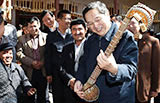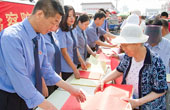News Analysis: China-S. Korea FTA to give opportunity for creating advanced industries
(xinhuanet.com) Updated: 2015-09-23 15:18by Yoo Seungki
SEOUL, Feb. 25 (Xinhua) -- Free trade agreement (FTA) between China and South Korea would give both countries an opportunity to jointly create and develop advanced industries as demand for high- quality products would rise before the bilateral free trade pact is completely implemented.
China and South Korea initialed the bilateral pact Wednesday, about three months after the two sides concluded negotiations on it. The two countries began talks on the deal in May 2012.
South Korea's trade ministry said it aimed to officially sign the deal with China within the first half of this year and implement it as rapidly as possible by getting approval from the parliament. The deal, now written only in English, will be translated into native languages of the two countries before it is officially signed.
The ministry said the country would use the FTA with China as new growth engine as the pact would allow South Korea to make inroads into China. It said the Chinese economy expands more than 7 percent each year.
"China is turning from the world's factory to the world's ( consumer) market. Chinese consumers want high value-added products based on state-of-the-art technologies, not products simply assembled with parts," Han Jae-Jin, senior research fellow at the Hyundai Research Institute, said in a telephone interview.
"(South) Korea-China FTA should act as a chance for both countries to strengthen cooperation in developing high value-added industries to meet such demand. (South) Korea should come up with how to create and develop high value-added industries during the 20-year grace period," said Han.
Under the accord, South Korea will eliminate tariffs on 92 percent of all products from China within 20 years after the FTA implementation in return for China abolishing tariffs on 91 percent of all South Korean goods.
The 20-year grace period came as Beijing and Seoul shared a view that it needs time before completely opening markets to minimize possible damages to the industries of both countries.
China and South Korea have changed their trade focus from low value-added industries to advanced sectors, but both sides need more advancement in each industry structure. By jointly developing high value-added industries during the grace period, the FTA would become a win-win solution for the two nations, the researcher said.
According to data from the Korea International Trade Association (KITA), trade product between China and South Korea has changed from low value-added to high value-added ones.
In 1992, when the two countries forged diplomatic ties, steel plate was South Korea's largest export product to China with the former's annual export of steels to the latter amounting to 420 million U.S. dollars. It was followed by synthetic resins with 300 million dollars in exports.
In 2013, semiconductor was South Korea's largest export product in trade with China. South Korea exported chips worth 21.67 billion dollars to China, accounting for about 15 percent of the former's total shipments to the latter, the KITA data showed. It was trailed by flat screens and sensors worth 18.56 billion dollars of exports.
Statistics from the Export-Import Bank of Korea show that from 1992 to 2013, direct investment of South Korean companies in China 's electric, electronic and chip industries surged about 190 times from 17 million dollars to 3.1 billion dollars. During the same period, direct investment in China's auto and auto parts sectors jumped from 6.3 million dollars to 476.4 million dollars.
Technology cooperation has increased. Joint research projects between the two countries rose from 39 in 2005 to 186 in 2011, according to the Hyundai Research Institute.
Trade between China and South Korea kept rising from 6.4 billion dollars in 1992 to 228.9 billion dollars in 2013. China has been South Korea's biggest trading partner since 2004.
Editor: Mu Xuequan
- Most terrorist groups knocked out at planning stage: White paper
- Shanghai slaps three-year ban on entertainers caught doing drugs
- China issues white paper on Xinjiang ethnic equality, unity
- Another corruption suspect repatriated from US to China
- Cross-border triad operation snares 19,000 crime suspects
- Leaders target ongoing bureaucratic inaction
- Beijing to add bicycles, crack down on illegal parking
- Wastewater cleaning finished at Tianjin blast site
- 877 investigated for corruption in financial sector
- Xinjiang gets a helping hand to improve locals' livelihoods







